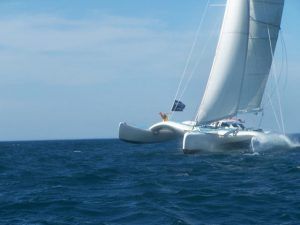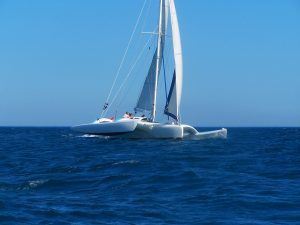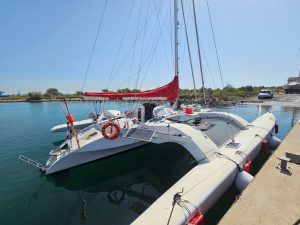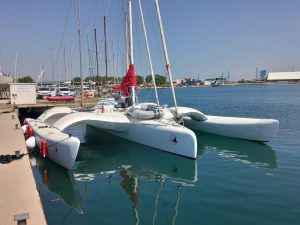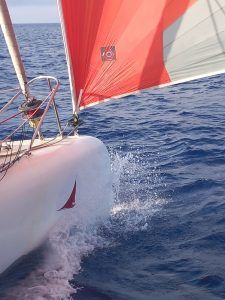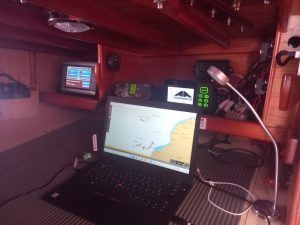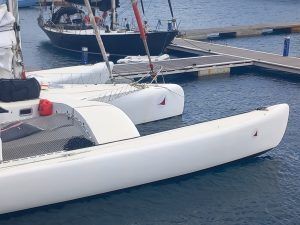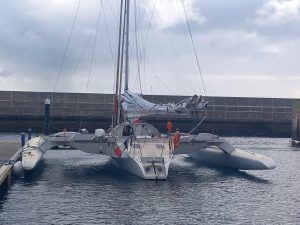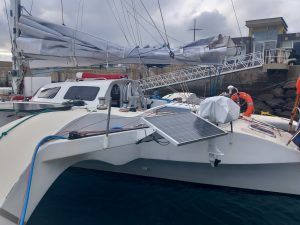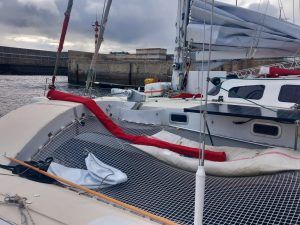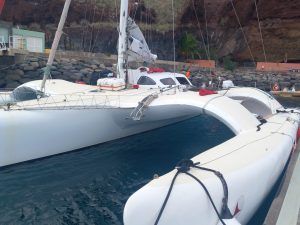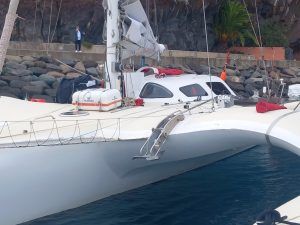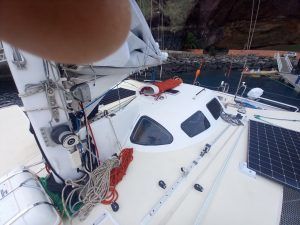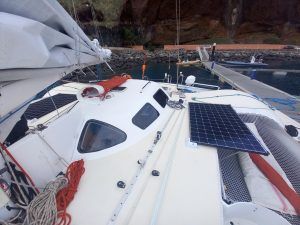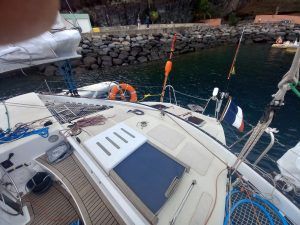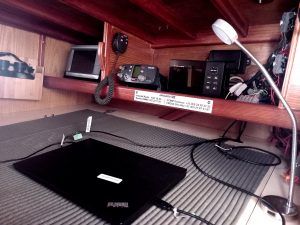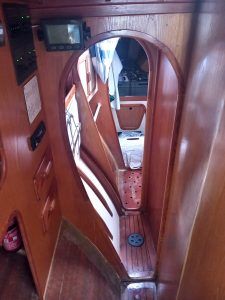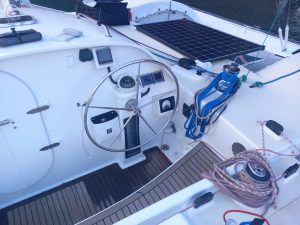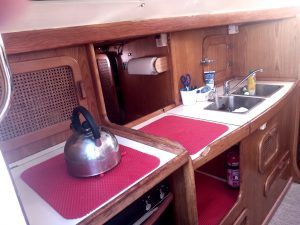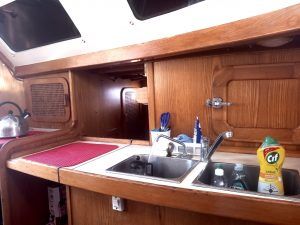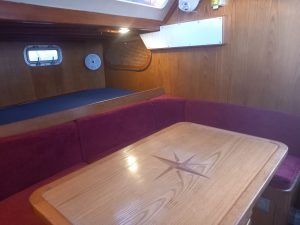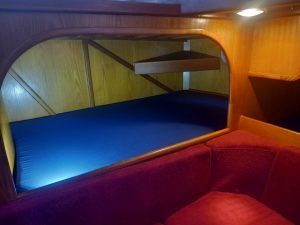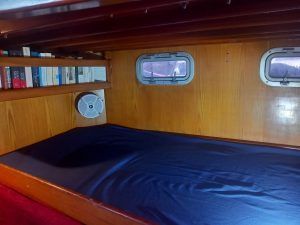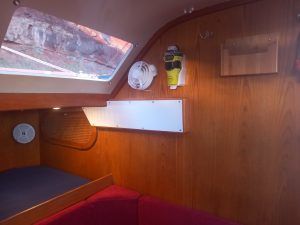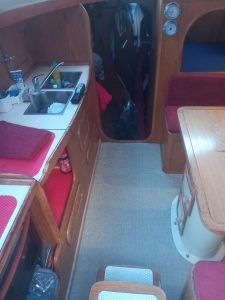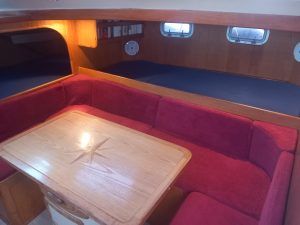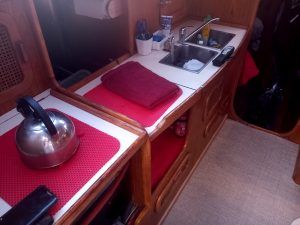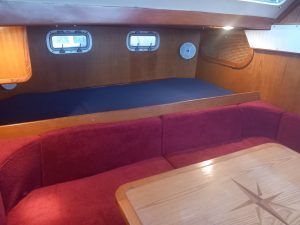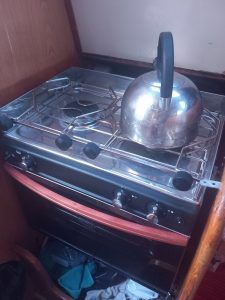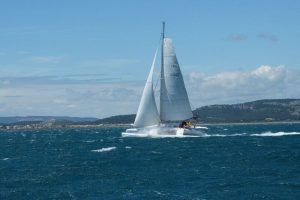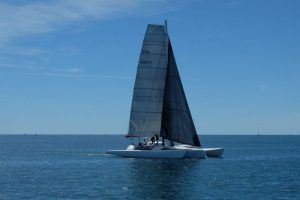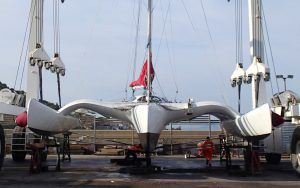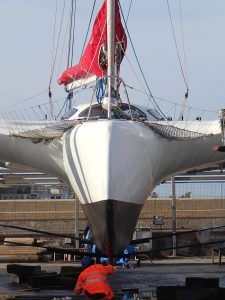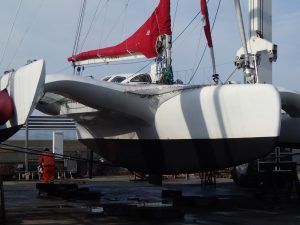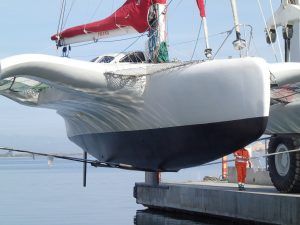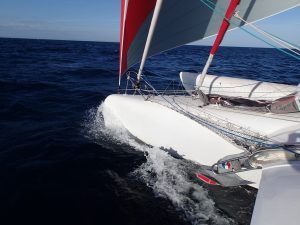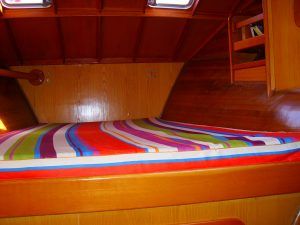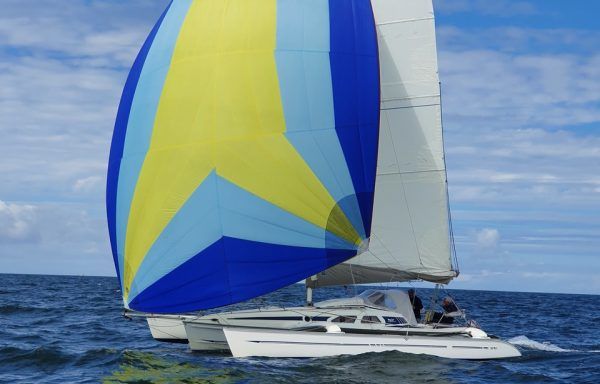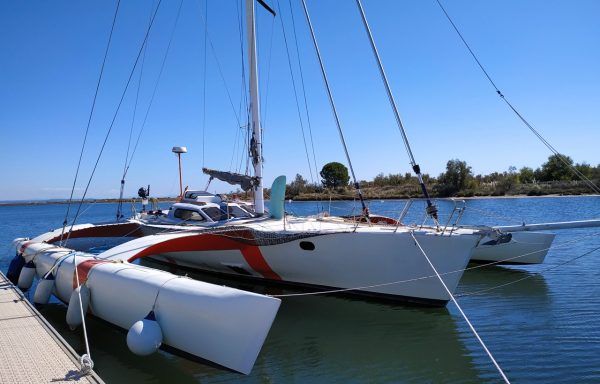How was the Polynesie 45 ATOUVA designed by Philippe Rivière:
It all starts with long discussions with the client to identify, as best as possible, his wishes.
This is followed by the development of a preliminary project which aims to put on paper a summary of the discussions.
This preliminary project presents the general outline of the boat, the sail plan,
the main characteristics (including an estimate of the empty weight and the displacement when loaded), the fittings.
We can go over this preliminary project several times until we obtain the client’s full agreement.
Once the preliminary project is finalized, we must go over (with great care) the estimates of empty weight and displacement when loaded.
We can then start drawing the central hull…- Central Hull:
on a multihull, there is a very important factor: the waterline length / waterline width ratio.
A ratio of 12 gives very good results.
For a cruising boat, you can go down to 8, but not less.
A racing boat will have a ratio of around 16 or more.
In our case (central hull of a racing-cruising trimaran): the displacement under load allows us to use a waterline length / waterline width ratio of 12.
The waterline is as taut as possible with the smallest possible water entry angle, but without concavity. Once the waterline is drawn, we can define the main bulkhead (a half circle), placed at 60% of the waterline.
Starting from the main bulkhead, the central hull develops forward with U-shaped shapes and aft with flattening aft shapes (to limit pitching).
We spend a lot of time (on the computer) to obtain the prismatic coefficient and the area curve that are suitable for the navigation program.
OSCAR, WAPA 50, EXPRESSO, SANTAL, HICKORY and even the catamarans ACAJOU, NIOMINKA, ILOMBA, TROPIQUES EXPRESS are designed according to these principles.
– Floats:
The volume of the floats is of the order of 150% of the displacement under load.
The floats are at the maximum length.
They are in a rounded V shape.
Longitudinally, their banana shape allows to have a constant waterline length / waterline width ratio (high) according to the sinkage and also allows to limit the wetted surface in light winds (low sinkage).
The position of the width at maximum waterline advances as the sinking progresses, to combat digging in – Platform:
If Dick Newick bets everything on lightness, I am more of the Walter Greene school who sought to have the most rigid platforms possible (even if it means being a little heavier) to obtain a rigid rigging and therefore, allow the sails to work in the best conditions.
The bottom of the front arms merges with the hull to avoid having a transverse structure that would cut the fittings too much.
The arms are made of a lot of laminated wood plus UD glass (no carbon at all).
– Rudder – centerboard:
Vertical sabre centerboard placed behind the mast.
Rudder with fin, liftable, Newick style.As soon as it has been launched after a large refit, Atouva has proven to be solid, comfortable, safe and very fast (15-25 knots). It is a perfect combination
of beauty, performance and comfort. Atouva can’t hide its Newick heritage but its interior is incredibly roomy. This boat is made for
conoisseurs !Big separate double berth, double berth accross in front of the
saloon, fore cabin.
Technical Description Trimaran JANGADA VIII
· 1 – ADMINISTRATIVE INFORMATION
– Pleasure craft with sails and auxiliary engine of the fast cruising trimaran type built individually
– Model POLYNESIE 45
– Flag FRANCE
– Home port LA ROCHELLE
– Francization 47105042501 (B6105) on 05/11/2021
– Registration LR B76841 on 05/11/2021
– Year of commissioning 2002
– Builder Georges CARDONA
– Reconditioning 2021/2024
– Naval Architect Philippe RIVIERE
– CE design category A
– Radio call sign FAC3084
– MMSI number 227 271 770
– Length 14.02 m
– Width 10.49 m
– Draft 1.20 m / 2.50 m (central sabre centerboard)
– Light displacement (approximately) 6.00 tonnes
– Inboard diesel propulsion engine YANMAR 3YM30AE 30 HP / 21.3 KW
– Construction materials Strip-planking red cedar epoxy glass
and CP epoxy glass
– Fresh water capacity 1 tank 600 liters
– Diesel capacity 1 tank 160 liters
– Number of berths 5 including 2 doubles
· 2 – EXTERIOR/INTERIOR FITTINGS
a) Exterior
The boat has a central hull with a fitted step built in strip-planking red cedar/epoxy/glass. The deck is in CP/epoxy/glass. The curved front and rear arms are in wood/epoxy/glass. The 2 floats, heavily partitioned, originally blind and still unfitted, are now fitted between the 2 arms with a LEWMAR cover allowing access to the compartment located behind the backstay chainplates (replaced). 9 deck fillers (2024) per float allow possible drying of the watertight compartments of the floats. The habitability of the central hull is exceptional for a trimaran. The deck plan includes 2 pairs of trampoline-type nets. The windlass and its anchor locker are offset on the port forward arm. 2 large solar panels of 400 W each have been installed on either side of the roof (2024), in addition to the 2 100 W individual panels previously installed on the curved support of the mainsail sheet track. The vertical centerboard well is located immediately aft of the mast, forward of the roof. The cockpit for maneuvering and watchkeeping is located in the 3/4 aft position. The main companionway leading to the saloon, the galley, the central berths, the navigation area and the front of the boat is located on the front of the cockpit, while access to the aft double cabin is located on the deck immediately aft of the cockpit. The transom is equipped with 2 steps and a stainless steel liftable swimming ladder. The boat is equipped with a central sabre-type centerboard in epoxy laminated fiberglass wood, movable in a vertical well, while the rudder is mounted on a rotation axis associated with a locking axis allowing it to be partially raised, necessary for dismantling the shaft line.
b) Interior
The front compartment of the central hull includes at the very front a watertight peak/crash box. Aft of the collision bulkhead, the original single V-shaped forward berth has been removed and transformed into a storage space (plastic boxes).
Then, behind this storage space is the toilet compartment with shower, sink, and closed toilet.
A passageway located on the port side of the centerboard well then serves the chart table and the navigation area, while a central double berth, accessible from the saloon, and comprising on the lower level a large volume
The saloon is located opposite the galley to starboard, and provides access to a single navigation or spare berth. The 160-litre diesel tank and the 600-litre fresh water tank are located under the saloon. The same applies to the service and engine starter batteries.
Under the aft bench seat in the saloon is a cupboard containing the battery charger, solar panel regulators and battery switches.
The cockpit, which includes the main controls (winches, jammers, etc.), engine controls, helm and displays for the navigation centre and autopilot, includes on the port side a gas compartment equipped with 2 13 kg bottles (2024), as well as a seawater deck/anchor wash socket (2024).
Under the cockpit is installed on 2 levels the engine compartment, with on the lower level the Yanmar 30 HP diesel engine type 3YM30AE, its peripherals and its shaft line with stuffing box driving a Volvo 3-blade folding propeller. On the upper level are the water heater, the watermaker (2024, assembly to be completed) and part of the electrical networks. The engine compartment is accessible from the saloon or from the aft cabin (hatch open in 2024).
A companionway located on the deck immediately aft of the cockpit provides access to the independent aft cabin. This very spacious cabin has a large 1.60 m double bed and storage.
Treadmaster anti-slip plates have been epoxy glued on the aft part of the deck (2024).
The transom has 2 steps allowing access to the water via a liftable stainless steel swim ladder. The rudder locking axis in the low position is accessible by 2 watertight screwed hatches located at the level of the steps.
• 3 – MATURE – RIGGING – SAILS
– 18 m Sparcraft aluminum alloy mast painted white with 1 level of pusher spreaders and 1 discontinuous diamond, 2 winches, jammers and cleats.
– Sparcraft aluminium alloy boom painted white, 3 reefs fittings
– New stainless steel chainplates for cap shrouds and lower shrouds (2024)
– Sparcraft Rigging stainless steel standing rigging
1 main forestay with Profurl solent furler (2015)
1 lower forestay with Profurl staysail furler (2015)
2 cap shrouds diam 12 mm (2024)
2 lower shrouds diam 8 mm (2024)
1 pair of Dynnema runners with Harken Black Magic blocks (2015)
1 level of pusher spreaders with discontinuous diamond
– 1 Profurl Nex 2.5 Code D furler
– 1 Profurl Nex 2.5 Gennaker furler
– Delta Voiles sails
Mainsail 74.1 m2 full batten 7 horn battens on Antal boxes and
FACNOR trolleys (recent, new condition)
Furling genoa 48 m2 (2015) good condition
Code D 115.1 m² Maxilite triradial (2013) very good condition
Code 0 50 m² Pentex triradial new condition
Storm staysail 35 m² (2013) fair condition
Mainsail cover (2024) new December 2024
Lazy-jacks
– running rigging (2024)
• 4 – FITTINGS/RUNNING RIGGING
– 6 winches i.e. 2 x 52 ST Andersen, 2 x 46 ST Andersen, 2 x 43 ST Lewmar including 1 aluminum on mast (2024) / 4 handles (2024)
– Complete Harken, Frederiksen, Lewmar blockage (completed in 2024)
– Sheet rail/carrying system
– LEWMAR jammers (2024), cleats, fairleads, padeyes, etc.
– Various maneuvers and tackles
– Mainsail halyards, solent, staysail (2024)
– Spinnaker halyard, Mainsail topping lift, Mainsail sheet
– Solent and spinnaker/gennaker sheets, boom retainer, barber-hauler, etc.
– Reefing lines and mainsail tensioning line (2024)
– 4 GOIOT deck hatches on central hull, 1 LEWMAR hatch on roof (2024)
– 2 LEWMAR float panels (2024)
– 1 GOIOT survival hatch
– 1 set of 4 trampolines (2015)
– 4 cleats mooring by floats (1 additional on each side 2024)
– 1 set of lifelines (revised 2024)
– 1 set of balconies (3) and stainless steel stanchions
– 1 telescopic stainless steel swim ladder (2024)
– 2 reflective strap lifelines (2024)
– 6 fixed roof portholes including 4 new (2024)
– 2 fairleads and 1 large re-centered mooring cleat added to the front on the central hull (2024)
– stainless steel martyrs added 2024
• 5 – ANCHORING
– Lofrans Cayman 12V/1000W windlass with doll/gypsy (2024)
– 10mm 60m chain (2024)
– 1 re-galvanized 20 kg Brake anchor (2024)1 Fortress FX 37 light anchor (2024)
• 6 – MECHANICAL PROPULSION
– 1 Yanmar 3YM30 AE 30 HP Diesel propulsion engine at 3200 rpm (June 2015) (approximately 700 hours of operation)
– Hurth mechanical inverter
– Shaft line with 2 hydrolube bearings (2024) and stuffing box (2024)
– Volvo 3-blade folding propeller 15 x 10 blades 14 x 9 (2013)
– Attwood machine fan (2024)
– Consumption of 2.5l to 4.0 liters depending on speed
– Cruising speed 6.0 knots 3.0 l/h at 2200 rpm
• 7 – ELECTRICITY
– Hybrid Gel/AGM service batteries 4 x 100 Ah/12V (2024)
– MP 95 Ah/12 V starter battery (2024))
– 1 Mastervolt 35 A 220/12 V battery charger
– 1 Victron BMV 702 battery monitor (2024)
– 1 Victron Argofet 100-3 100 A charge distributor (2024)
– 1 12V alternator coupled to the propulsion engine (2021)
– 1000 W of solar panels divided into:
2 100 W individual panels, i.e. 200 W (2015)
2 SUNPOWER MAXEON panels, i.e. 400 W individual power, i.e. 800 W (2024)
– 3 Victron Smart Solar charge regulators
– 1 220 V shore power socket
– 1 220 V internal network (3 sockets) on shore power or GE circuit
– 1 inverter 12V/220V 500 W(2024)
• 8 – FRESH WATER
– 1 600 litre epoxy wood laminated tank with electric gauge (2024)
– 1 PKC 12 V 60 litres/h watermaker (2024) (assembly to be finished)
– 1 hot/cold water hydrophore unit
– 1 220 V hot water tank and engine (2013)
– 2 water points + shower
• 9 – GAS OIL
– 1 140 litre epoxy wood laminated tank with sight gauge
– 1 decanter pre-filter with manual priming pump (2024)
– pre-filter and filter on engine
• 10 – SEA WATER
– Seawater washing circuit deck/anchorage (2024)
– EM cockpit socket and hose, EM sink tap (2024)
– Marine toilet Jabsco (2024)
• 11 – GAS INSTALLATION
– ENO 2-burner gas cooker, grill and oven, powered by 2 13 kg butane gas bottles, new hose (set from 2024)
• 12 – DRAINING
– 12 V waste water pump in toilet compartment (2024)
– 12 V bilge pump in engine compartment (2024)
• 13 – COLD
– 12 V air-cooled refrigeration unit supplying the kitchen refrigerator
• 14 – STEERING GEAR
– Steering gear with 4 mm diam stainless steel cable lines (new 2024)
– GARMIN GHC 20 electric autopilot to starboard cockpit, chain drive
– Lifting rudder with locking pin in low position
• 15 – NAVIGATION/TELECOMMUNICATION
– 1 Plastimo Offshore 135 Plastimo steering compass
– 1 Garmin GPS MAP 720 navigation unit (2013) including:
1 GPS/map/plotter box at the chart table
2 Gmi 10 displays at the cockpit helm console
1 AIS 600 class B transceiver
– 1 Garmin GHC 20 autopilot (2014) at the cockpit helm console
– 1 Furuno GP 39 GPS (2024)
– 1 Radio-Ocean RO 4500 VHF transceiver (2014)
– 1 Nasa AIS receiver (2024)
– pre-assembly (AIS plug, NMEA 2000 plug) for navigation and cartography computer
– pre-assembly (power supply, external antenna on balcony) for Iridium Go satellite transmission equipment (2024)
– LED navigation lights (2024) including 1 360° flashing light at the top of the mast
– 1 EPIRB ACR-GLOBAL FIX V5 beacon (2024)
• 16 – HI-FI INSTALLATION
– 1 Pioneer MVH-330 DAB radio/CD/MP3 set 2 waterproof speakers in the saloon (2024)
• 17 – PAINT/DECORATION/UPHOLDER
– Awlgrip sand-coloured non-slip lacquer for hull deck and floats
– Seajet 039 Platinum black 3-layer antifouling (2024)
– New interior upholstery (mattresses, saloon cushions) (2024)
• 18 – SAFETY EQUIPMENT
– 1 6-seater liferaft in Plastimo container on stainless steel cradle (2024)
– 1 IOR pole with turning light and SOLAS crown buoy (2024)
– Life jackets for 8 people (2024)
– 2 safety harnesses and lanyards
– Hand-held flashing lights
– 1 pyrotechnic box required for offshore use
– 1 signaling mirror
– 1 fog horn
– analog barometer and hygrometer/thermometer
• 19 – VARIOUS ARMAMENT EQUIPMENT
– 1 3D Tender Twin Cat 280 4-seater 2.80 x 1.66 m annex
equipped with a 4-stroke Suzuki DF 6A 6 HP outboard engine (set from 2024)
– a set of various spare parts
– set of mooring lines (2024)
– 8 fenders (4 spherical from 2024 and 4 flat from 2015)
– 1 emergency tiller
– 3 fire extinguishers
– etc…
————————————————————————–
| Prix : | 190,000€ |
| Poids: | 5000 kg |
Description
PHOTOS SOUS LE TEXTE
Comment le Polynesie 45 ATOUVA a-t-il été dessiné par Philippe Rivière:
Tout commence par de longues discussions avec le client pour cerner , au mieux , ses souhaits .
S’en suit l’élaboration d’un avant-projet qui a pour but de mettre sur le papier une synthèse des discussions .
Cet avant-projet présente la silhouette générale du bateau , le plan de voilure ,
les caractéristiques principales ( dont une estimation du poids à vide et du déplacement en charge ) , les aménagements .
On peut reprendre plusieurs fois cet avant-projet jusqu’à obtenir le plein accord du client .
Une fois l’avant-projet finalisé , il faut reprendre ( avec beaucoup de soin ) les estimations de poids à vide et de déplacement en charge .
On peut , alors , commencer le tracé de la coque centrale …- Coque Centrale :
sur un multicoque , il y a un facteur très important : le rapport longueur de flottaison / largeur de flottaison .
Un rapport de 12 donne de très bons résultats .
Pour un bateau de croisière on peut descendre jusqu’à 8 , mais pas moins .
Un bateau de course aura un rapport de l’ordre de 16 ou plus .
Dans notre cas ( coque centrale de trimaran de course-croisière ) : le déplacement en charge permet d’utiliser un rapport longueur de flottaison / largeur de flottaison de 12 .
La ligne d’eau de flottaison est le plus tendue possible avec un angle d’entrèe d’eau le plus réduit possible , mais sans concavité . Une fois la ligne d’eau de flottaison tracée , on peut définir le maître-couple ( un demi cercle ) , placé à 60 % de la flottaison .
En partant du maître-couple , la coque centrale se développe vers l’avant avec des formes en U et vers l’arrière avec des formes arrières s’applatissant ( pour limiter le tangage ) .
Nous passons beaucoup de temps ( sur l’ordinateur ) pour obtenir le coefficient prismatique et la courbe des aires qui conviennent au programme de navigation .
OSCAR , WAPA 50 , EXPRESSO , SANTAL , HICKORY et même les catamarans ACAJOU , NIOMINKA , ILOMBA , TROPIQUES EXPRESS sont dessinés selon ces principes .
– Flotteurs :
Le volume des flotteurs est de l’ordre de 150 % du déplacement en charge .
Les flotteurs sont à la longueur maximale .
Ils sont en V arrondi .
Longitudinalement , leur forme bananée permet d’avoir un rapport longueur flottaison / largeur de flottaison ( élevé ) constant selon l’enfoncement et
permet , également , de limiter la surface mouillée dans le petit temps ( faible enfoncement ) .
La position de la largeur à la flottaison maximale avance au fur et à mesure de l’enfoncement , pour combattre l’enfournement – Plateforme :
Si Dick Newick mise tout sur la légèreté , je suis plutôt de l’école Walter Greene qui a cherché à avoir des plateformes les plus rigides possibles
( quitte à être un peu plus lourdes ) pour obtenir un gréement rigide et donc , permettre aux voiles de travailler dans les meilleures conditons .
Le bas des bras avant vient se confondre avec la coque pour ne pas avoir de structure transversale qui couperait trop les aménagements .
Les bras sont constitués de beaucoup de bois lamellés plus des UD verre ( pas du tout de carbone ).
– Safran – dérive :
Dérive sabre verticale placée derrière le mât .
Safran avec aileron , relevable , à la Newick .
Caractéristiques
| Modèle / Version | POLYNÉSIE 45 |
| Chantier / Boatyard | CONSTRUCTION INDIVIDUELLE GEORGES CARDONA |
| Architecte / Architect | Philippe Riviere |
| Année de construction / Launching year | 2002 |
| Matériaux / Material | STRIP PLANKING (composite bois latté époxy verre) et CP époxy verre |
| Pavillon / Flag | Français |
| TVA Payée / Paid VAT | oui/yes |
| Longueur / LOA | 14,02 m |
| Largeur / Beam | 10,49 m |
| Tirant d'eau / Draft | 1,20/2,50 dériveur intégral si safran relevé m |
| Poids / Weight | 6000 kg |
| Surface au près / Winward sail surface | 122 m² |
| Système anti-dérive / Keel type | Dérive sabre |
| Motorisation / Engines | Yanmar 30hp 700h |


